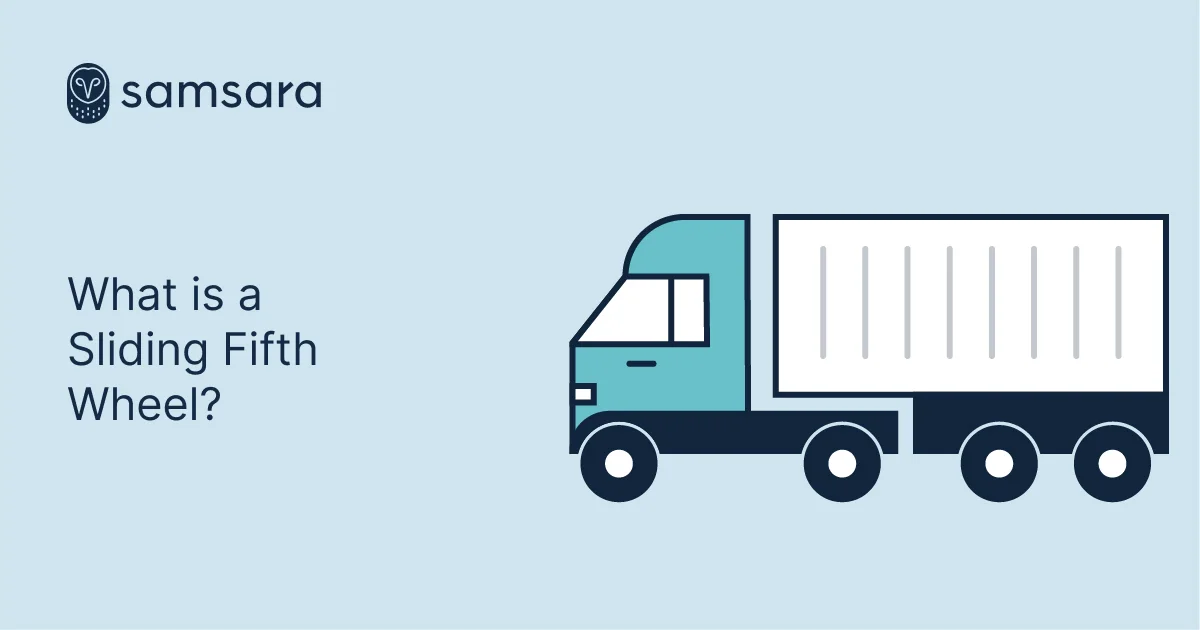What is a Sliding Fifth Wheel?
October 22, 2021

Get Started with Samsara
Check our pricesKey Takeaways
The fifth wheel is an important mechanism for coupling a tractor unit with a trailer. Sliding fifth wheels, in particular, allow carriers to haul a variety of loads because tractors can hitch to different kinds of trailers, weighing different amounts, with different weight distributions.
What is a sliding fifth wheel?
In the trucking industry, a sliding fifth wheel is a coupler that links a tractor unit and semi-trailer together with a mechanism that slides the coupler forward and backward. The fifth wheel is mounted to the tractor’s frame, but it can move on the frame rails, unlike a fixed fifth wheel. This back and forth movement allows drivers to adjust the weight distribution on the steer axles and drive axles and increases the separation between the truck and trailer its towing.
The term “fifth wheel” comes from the days of horse-drawn wagons. The “fifth wheel” was the front pivot mechanism connected to the wagon’s front axle, allowing steering from side to side. A tractor now does the job of pulling horses and steering functionality. The fifth wheel coupler allows a trailer to turn.
Smaller versions of the sliding fifth wheel can be mounted to heavy-duty pickup trucks (including short bed trucks) for towing campers and fifth wheel trailers.
How does a sliding fifth wheel work?
The fifth wheel hitch is a large, flat plate shaped like a horseshoe. A metal rail beneath the hitch attaches to the tractor’s frame for strength. Unlike a gooseneck hitch which uses a ball hitch to haul, the slider hitch connects to semi-trailers via a kingpin. This is a 2-or-3 ½-inch diameter vertical steel pin that protrudes from the bottom front of the trailer. The kingpin can lock into position in the horseshoe coupler, so it’s secure but can pivot to accommodate turns.
The sliding hitch moves on base rails and is held in place by locking pins on the rails, similar to trailer tandem holes. Slider pins need to be lubricated consistently to keep them sliding freely. Once the pins are released, truck drivers can slowly move the tractor—while the trailer’s landing gear is down—forward or rearwards depending on where they need to move the weight.
A general rule of thumb is that every cog or notch on the fifth wheel slider represents 100 pounds.
What’s the difference between a sliding vs. fixed fifth wheel
While drivers can adjust the fifth wheel on most tractors, they may encounter fixed hitches that do not move. But when would drivers opt to use each of these couplers?
Fixed fifth wheels are best suited for pulling trailers with consistent loads. The weight doesn’t change significantly across jobs in these cases, thus not requiring weight distribution adjustments. Consequently, a fixed fifth wheel restricts the flexibility to haul different kinds of un-uniform freight. Bulk or tank carriers typically are use cases for fixed fifth wheels.
On the other hand, a sliding fifth wheel allows a tractor to haul a wider variety of freight. It is suited for hitching to different kinds of trailers, weighing different amounts, with different weight distributions. Because most loads are not uniform, having the sliding fifth wheel allows the driver to adjust accordingly. While the sliding fifth wheel hitch weighs more and is more expensive, it also allows for more versatility.